Turns out “Pompeii’s Unluckiest Man” may not have been that unlucky, after all.
When archaeologists first found a man’s skeleton near Mount Vesuvius, it appeared to have been crushed by a boulder while fleeing from the nearby volcano’s eruption in 79 A.D. Only his skeletal legs and lower torso could be seen from underneath a 600-pound rock. Archaeologists theorized at the time that a volcanic cloud had most likely launched a stone door jamb toward the man, decapitating him. But this now seems not to be the case. Further digging unearthed the man’s intact skull with his mouth wide open and full of teeth, as well as his upper torso, about three feet directly below the rest of the body and the gigantic stone. Archaeologists are convinced the bones belong to the same person because of their proximity to each other and the two halves matched up.
“The death of the victim arrived not because of the block falling on the skull,” said Massimo Osanna, the director of the Pompeii archaeological site, according to the New York Times. “Our new hypothesis is that he died from asphyxiation from the pyroclastic flow.”
Thanks for reading InsideHook. Sign up for our daily newsletter and be in the know.


















